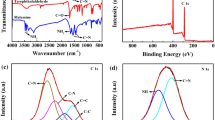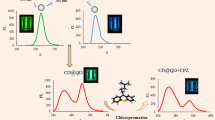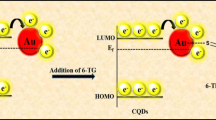Abstract
A MnO2 nanosheet-assisted ratiometric fluorescence probe based on carbon quantum dots (CQDs) and o-phenylenediamine (OPD) has been developed for the detection of the anticancer drug 6-mercaptopurine (6-MP). CQDs with strong fluorescence are synthesized via the one-step hydrothermal method. MnO2 nanosheets as an oxidase-mimicking nanomaterial directly oxidize OPD into 2,3-diaminophenazine (DAP) which has a fluorescence emission at 570 nm, whereas the fluorescence of CQDs at 445 nm is then reduced by the DAP through the inner filter effect (IFE) under a single excitation wavelength (370 nm). After adding 6-MP, MnO2 nanosheets can be reduced to Mn2+ and lose their oxidase-like property, blocking the IFE with the fluorescence decrease of DAP and fluorescence increase of CQDs. The novel ratiometric fluorescence probe exhibits considerable sensitivity toward 6-MP and linear response is in the 0.46–100.0 μmol L−1 concentration range with the detection limit of 0.14 μmol L−1. Furthermore, the probe shows good selectivity when exposed to a series of interfering other organic and inorganic compounds, and biomolecules and can be applied to the detection for 6-MP in human serum samples and pharmaceutical tablets. Satisfactory recoveries of 6-MP in human serum samples are in the range 96.1–110.9% with the RSD of 1.4 to 3.2%. The amount of 6-MP is successfully estimated as 49.3 mg in pharmaceutical tablet with the RSD of about 2.2%.
Graphical abstract







Similar content being viewed by others
References
Sahasranaman S, Howard D, Roy S (2008) Clinical pharmacology and pharmacogenetics of thiopurines. Eur J Clin Pharmacol 64(8):753–767
Qiu J, Cheng R, Zhang J, Sun H, Deng C, Meng F, Zhong Z (2017) Glutathione-sensitive hyaluronic acid-mercaptopurine prodrug linked via carbonyl vinyl sulfide: a robust and CD44-targeted nanomedicine for leukemia. Biomacromolecules 18(10):3207–3214
Mowat C, Arnott CA, Smith M, Ahmad T et al (2016) Mercaptopurine versus placebo to prevent recurrence of Crohn’s disease after surgical resection (TOPPIC): a multicentre, double-blind, randomised controlled trial. Lancet Gastroenterol Hepatol 1(4):273–282
Mottet C, Schoepfer AM, Juillerat P, Cosnes J, Froehlich F, Kessler-Brondolo V, Seibold F, Rogler G, Vavricka SR, Michetti P (2016) Experts opinion on the practical use of azathioprine and 6-mercaptopurine in inflammatory bowel disease. Inflamm Bowel Dis 22(11):2733–2747
Biparva P, Abedirad SM, Kazemi SY (2015) Silver nanoparticles enhanced a novel TCPO H2O2-safranin O chemiluminescence system for determination of 6-mercaptopurine. Spectrochim Acta A Mol Biomol Spectrosc 145:454–460
Shahrokhian S, Ghorbani-Bidkorbeh F, Mohammadi A, Dinarvand R (2011) Electrochemical determinations of 6-mercaptopurine on the surface of a carbon nanotube-paste electrode modified with a cobalt salophen complex. J Solid State Electrochem 16(4):1643–1650
Rawat KA, Singhal RK, Kailasa SK (2017) One-pot synthesis of silver nanoparticles using folic acid as a reagent for colorimetric and fluorimetric detections of 6-mercaptopurine at nanomolar concentration. Sensors Actuators B Chem 249:30–38
Mawatari H, Kato Y, Nishimura S, Sakura N, Ueda K (1998) Reversed-phase high-performance liquid chromatographic assay method for quantitating 6-mercaptopurine and its methylated and non-methylated metabolites in a single sample. J Chromatogr B 716:392–396
Fu WL, Zhen SJ, Huang CZ (2014) Controllable preparation of graphene oxide/metal nanoparticle hybrids as surface-enhanced Raman scattering substrates for 6-mercaptopurine detection. RSC Adv 4(31):16327–16332
Arcudi F, Dordevic L, Prato M (2019) Design, synthesis, and functionalization strategies of tailored carbon nanodots. Acc Chem Res 52(8):2070–2079
Long YM, Zhou CH, Zhang ZL, Tian ZQ, Bao L, Lin Y, Pang DW (2012) Shifting and non-shifting fluorescence emitted by carbon nanodots. J Mater Chem 22(13):5917–5920
Li Q, Ohulchanskyy TY, Liu RL, Koynov K, Wu DQ, Best A, Kumar R, Bonoiu A, Prasad PN (2010) Photoluminescent carbon dots as biocompatible nanoprobes for targeting cancer cells in vitro. J Phys Chem C 114:12062–12068
HuangYF Zhou R, Zhang H, Kang KB, Zhao M, Peng Y, Wang Q, Zhang HL, Qiu WY (2014) One-potsynthesis of highly luminescent carbon quantum dots and theirnontoxic ingestion by zebrafish for in vivo imaging. Chemistry 20(19):5640–5648
Chen ZB, Wang J, Miao H, Wang L, Wu S, Yang XM (2015) Fluorescent carbon dots derived from lactose for assaying folic acid. Science China Chem 59(4):487–492
Cao L, Sahu S, Anilkumar P, Bunker CE, Xu J, Fernando KA, Wang P, Guliants EA, Tackett KN, Sun YP (2011) Carbon nanoparticles as visible-light photocatalysts for efficient CO2 conversion and beyond. J Am Chem Soc 133(13):4754–4757
Luo PG, Sahu S, Yang ST, Sonkar SK, Wang J, Wang H, LeCroy GE, Cao L, Sun YP (2013) Carbon “quantum” dots for optical bioimaging. J Mater Chem B 1(16):2116–2127
Feng T, Ai X, An G, Yang P, Zhao Y (2016) Charge-convertible carbon dots for imaging-guided drug delivery with enhanced in vivo cancer therapeutic efficiency. ACS Nano 10(4):4410–4420
Pang W, Jiang P, Ding S, Bao Z, Wang N, Wang H, Qu J, Wang D, Gu B, Wei X (2020) Nucleolus-targeted photodynamic anticancer therapy using renal-clearable carbon dots. Adv Healthc Mater 9(16):2000607–2000614
Li L, Yu B, You TY (2015) Nitrogen and sulfur co-doped carbon dots for highly selective and sensitive detection of Hg (II) ions. Biosens Bioelectron 74:263–269
Yan X, Kong D, Jin R, Zhao X, Li HX, Liu FM, Lin YH, Lu GY (2019) Fluorometric and colorimetric analysis of carbamate pesticide via enzyme-triggered decomposition of gold nanoclusters-anchored MnO2 nanocomposite. Sensors Actuators B Chem 290:640–647
Han X, Meng Z, Xia L, Qu F, Kong RM (2020) o-Phenylenediamine/gold nanocluster-based nanoplatform for ratiometric fluorescence detection of alkaline phosphatase activity. Talanta 212:120768–120775
Han Z, Nan D, Yang H, Sun Q, Pan S, Liu H, Hu XL (2019) Carbon quantum dots based ratiometric fluorescence probe for sensitive and selective detection of Cu2+ and glutathione. Sensors Actuators B Chem 298
Peng C, Xing H, Fan X, Xue Y, Li J, Wang E (2019) Glutathione regulated inner filter effect of MnO2 nanosheets on boron nitride quantum dots for sensitive assay. Anal Chem 91(9):5762–5767
Singh R, Kashayap S, Singh V, Kayastha AM, Mishra H, Saxena PS, Srivastava A, Singh RK (2018) QPRTase modified N-doped carbon quantum dots: a fluorescent bioprobe for selective detection of neurotoxin quinolinic acid in human serum. Biosens Bioelectron 101:103–109
Ma Y, Chen AY, Huang YY, He X, Xie XF, He B, Yang JH, Wang XY (2020) Off-on fluorescent switching of boron-doped carbon quantum dots for ultrasensitive sensing of catechol and glutathione. Carbon 162:234–244
Wei S, Yin X, Li H, Du X, Zhang L, Yang Q, Yang R (2020) Multi-color fluorescent carbon dots: graphitized sp2 conjugated domains and surface state energy level co-modulate band gap rather than size effects. Chem Eur J 26(36):8129–8136
Duan L, Du X, Zhao H, Sun Y, Liu W (2020) Sensitive and selective sensing system of metallothioneins based on carbon quantum dots and gold nanoparticles. Anal Chim Acta 1125:177–186
Han M, Wang L, Li S, Bai L, Zhou Y, Sun Y, Huan H, Li H, Liu Y, Kang Z (2017) High-bright fluorescent carbon dot as versatile sensing platform. Talanta 174:265–273
Gude V, Das A, Chatterjee T, Mandal PK (2016) Molecular origin of photoluminescence of carbon dots: aggregation-induced orange-red emission. Phys Chem Chem Phys 18(40):28274–28280
Zhang F, Liu H, Liu Q, Su X (2018) An enzymatic ratiometric fluorescence assay for 6-mercaptopurine by using MoS2 quantum dots. Mikrochim Acta 185(12):540–547
Algar WR, Tavares AJ, Krull UJ (2010) Beyond labels: a review of the application of quantum dots as integrated components of assays, bioprobes, and biosensors utilizing optical transduction. Anal Chim Acta 673(1):1–25
Zu F, Yan F, Bai Z, Xu J, Wang Y, Huang Y, Zhou X (2017) The quenching of the fluorescence of carbon dots: a review on mechanisms and applications. Microchim Acta 184(7):1899–1914
Sun Z, Liu Y, Li Y (2015) Selective recognition of 6-mercaptopurine based on luminescent metal-organic frameworks Fe-MIL-88NH2. Spectrochim Acta A Mol Biomol Spectrosc 139:296–301
Shi M, Cen Y, Xu G, Wei F, Xu X, Cheng X, Chai Y, Sohail M, Hu Q (2019) Ratiometric fluorescence monitoring of alpha-glucosidase activity based on oxidase-like property of MnO2 nanosheet and its application for inhibitor screening. Anal Chim Acta 1077:225–231
The Pharmacopoeia Committee of the People’s Republic of China (2015) The pharmacopoeia of the People’s Republic of China (2nd part). China Medical Science and Technology Press, Beijing, p 1449
Funding
This work was financially supported by the National Natural Science Foundation of China (Grant No. 21705132) and the Fundamental Research Funds for the Central Universities (no. XDJK2019TY003).
Author information
Authors and Affiliations
Corresponding author
Ethics declarations
Conflict of interest
The authors declare that they have no competing interests.
Additional information
Publisher’s note
Springer Nature remains neutral with regard to jurisdictional claims in published maps and institutional affiliations.
Supplementary information
ESM 1
(DOCX 740 kb)
Rights and permissions
About this article
Cite this article
An, X., Chen, R., Chen, Q. et al. A MnO2 nanosheet-assisted ratiometric fluorescence probe based on carbon quantum dots and o-phenylenediamine for determination of 6-mercaptopurine. Microchim Acta 188, 156 (2021). https://doi.org/10.1007/s00604-021-04802-4
Received:
Accepted:
Published:
DOI: https://doi.org/10.1007/s00604-021-04802-4




